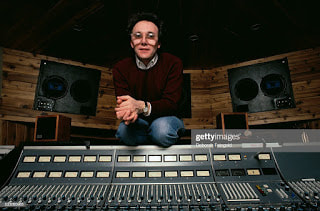|
By 1981 Trevor Horn had accomplished a lot as a musician. while playing bass in Tina Charles backing band, Horn recruited two of its members, Geoff Downes and Bruce Wooley, to do a 'Toto' and form a studio band called Buggles to record their own songs. After they wrote the song "Video Killed The Radio Star" together, Wooley left to form The Camera Club with, then unknowns, Thomas Dolby and Matthew Seligman and recorded his own version of the song. Of course the slickly produced version by Buggles was an international hit, the video for which launched MTV almost two years later. Then, in one of the oddest career left-turns ever documented, Buggles were tapped to replace the departed Jon Anderson and Rick Wakeman in Yes. This lineup recorded Drama, a strange album that mixed heavy metal with new wave, electronica and progressive rock. Trevor Horn (foreground) and Geoff Downes in their Buggles days A world tour followed which was successful in America but was savaged in their home country of England, mainly due to Horn's struggles with matching Anderson's high tenor. Yes broke up and Horn and Downes began recording a second Buggles album, during which Downes bolted to join his ex-Yes band mate Steve Howe in the massively successful Asia. Horn completed the album with session musicians and its failure potentially signaled the end of Horn's adventures in modern recording. So it was 1981 when Horn's wife and business partner, the late Jill Sinclair, suggested that Horn would only ever be a second rate artist but, as a producer, he could be a world beater. Sinclair's prescience proved uncannily accurate as Horn, using a series of fledgling bands like Dollar, ABC, Frankie Goes To Hollywood, Seal and non-musician Malcolm McLaren as his canvas, dreamed up great swaths of the eighties as we know it. Horn in his natural environment during his heyday as a producer Now, almost twenty years into the new millennium, there are no new hills to conquer, no more young hopefuls beating down his door to be synthesized into platinum superstars, and Horn has spent a lot of time looking back on his amazing career, performing Buggles reunion shows and playing bass in The Producers, a band similar in concept to The Rock Bottom Remainders which featured only authors like Stephen King, Amy Tan and Scott Turow. He produced another Jon Anderson-less album for Yes featuring mostly songs he and Geoff Downes had written for the band in 1980 - only to go back a few years later to remove their stand-in singer's voice and add his own. Horn's latest venture is another look backwards. The long lead time between the announcement of Trevor Horn Reimagines The Eighties and its release in the US had me salivating with anticipation for months. Unfortunately, now that it's finally here, I'm suffering from cotton mouth. Trevor Horn has reimagined the eighties as a bleak, post-apocalyptic musical landscape where once bouncy, spirited songs are reduced to funeral dirges or, worse, pared with singers whose particular gifts are ill-matched to the song they've been asked to sing. The first clue that something is amiss is the choice of Robbie Williams to sing Tears For Fears' "Everybody Wants To Rule The World." Williams' disinterested, flat delivery made me rush to listen to Curt Smith's original plaintive and hopeful approach, just to clean my palette. It gets worse before it gets better. English singer Gabrielle Aplin is forced to warble over a deconstructed, plodding arrangement of Bruce Springsteen's "Dancing In The Dark" that even Theresa May couldn't dance to. The less said about Seal's take on Bowie's "Ashes To Ashes" (the song that essentially announced the eighties) the better. With Seal The combination of Marillion singer Steve Hogarth and an overblown orchestral arrangement of Joe Jackson's "It's Different For Girls" makes the track sound like a rejected song from Yentl. Horn and Rumer turn "Slave To The Rhythm" (once a smash dance hit for Horn and Grace Jones) into a companion to Kate Bush's "This Woman's Work" where the rhythm in question might as well refer to contractions. Setting aside the pointless reading of Duran Duran's "Girls On Film" sung by All Saints, perhaps the most egregious reimagining on the album is former Spandau Ballet singer Tony Hadley's doomed attempt at Tina Turner's "What's Love Got To Do With It?" Why?! To be fair, there are a handful of tracks that work. Frankie Goes To Hollywood's "The Power Of Love," sung by Matt Cardle, lends itself nicely to Horn's dramatic approach, sounding like a contender for the next Bond Film. Dire Straits' "Brothers In Arms" is a song that transcends the eighties and, as performed by Simple Minds, is hard to ruin. My two favorite tracks on the album are sung by Horn, himself. "Owner Of A Lonely Heart," the Horn produced number one hit by Yes is stupid fun, especially when the samba kicks in before the guitar solo. Horn's reduction of A-ha's bouncy synth anthem "Take On Me" to a slow romantic ballad actually works beautifully. More like those would have been nice.
0 Comments
Leave a Reply. |
CategoriesAuthorsEric Sandberg: My true opinion on everything is that it's splunge. Archives
December 2022
Categories |
Proudly powered by Weebly




 RSS Feed
RSS Feed